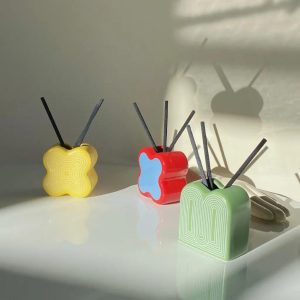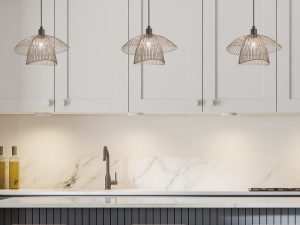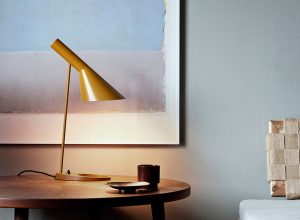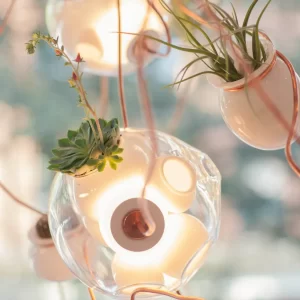Introduction
LED wall lamps Sevildesigns are a stylish and efficient lighting solution that have gained popularity in recent years. These lamps are designed to be mounted on the wall, providing both functional and decorative lighting. LED wall lamps offer a range of benefits, including cost savings, energy efficiency, and versatility in design options. They are a great choice for any room in the home or office, and can enhance the aesthetics of any space.
The Benefits of LED Wall Lamps
One of the main benefits of LED wall lamps is their cost savings and energy efficiency. LED lights use significantly less energy than traditional incandescent or fluorescent bulbs, which can lead to substantial savings on electricity bills. LED lights also have a longer lifespan, lasting up to 50,000 hours or more, compared to the average lifespan of incandescent bulbs which is around 1,200 hours. This means that LED wall lamps require less frequent replacement, saving both time and money.
In addition to cost savings and energy efficiency, LED wall lamps also offer several advantages over traditional lighting options. Unlike incandescent bulbs, which emit light in all directions, LED lights are directional, meaning they emit light in a specific direction. This makes them more efficient at illuminating a specific area or object. LED lights also produce less heat than traditional bulbs, reducing the risk of fire hazards and making them safer to use.
How LED Wall Lamps Enhance Aesthetics
LED wall lamps come in a wide range of designs and styles, making them a versatile choice for enhancing the aesthetics of any space. Whether you prefer a sleek and modern look or a more traditional design, there is an LED wall lamp to suit your taste. These lamps can be used as statement pieces or as subtle accents to complement existing decor.
LED wall lamps also have the ability to create ambiance and mood in a room. With dimmable options available, you can easily adjust the brightness of the light to create the desired atmosphere. Whether you want to create a cozy and intimate setting or a bright and vibrant space, LED wall lamps can help you achieve the desired effect.
The Versatility of LED Wall Lamps
LED wall lamps are a versatile lighting solution that can be used in any room in the home or office. They can be installed in bedrooms, living rooms, kitchens, bathrooms, and even outdoor spaces. LED wall lamps can be used as task lighting, providing focused illumination for activities such as reading or working. They can also be used as accent lighting, highlighting artwork or architectural features in a room.
In bedrooms, LED wall lamps can be used as bedside reading lights or as ambient lighting to create a relaxing atmosphere. In living rooms, they can be used to highlight a gallery wall or to provide soft, indirect lighting. In kitchens, LED wall lamps can be installed under cabinets to provide task lighting for food preparation. The possibilities are endless with LED wall lamps.
How LED Wall Lamps Can Improve Mood and Productivity
Lighting has a significant impact on mood and productivity. Bright, cool-toned light can help increase alertness and focus, while warm, dimmed light can promote relaxation and calmness. LED wall lamps offer the flexibility to adjust the brightness and color temperature of the light, allowing you to create the ideal lighting environment for any activity.
Several studies have shown that LED lighting can have a positive effect on mood and productivity. A study conducted by the University of Greenwich found that workers exposed to natural light or artificial light that mimicked natural light reported higher levels of alertness and productivity compared to those exposed to traditional fluorescent lighting. Another study published in the Journal of Environmental Psychology found that individuals exposed to blue-enriched light in the morning reported increased alertness and cognitive performance.
The Convenience of LED Wall Lamps
LED wall lamps are not only stylish and efficient, but they are also incredibly convenient to use. Installation is quick and easy, with most lamps simply requiring mounting on the wall and plugging into an electrical outlet. Many LED wall lamps also come with adjustable heads or arms, allowing you to direct the light exactly where you need it.
Maintenance and upkeep of LED wall lamps are minimal. Unlike traditional bulbs that need to be replaced frequently, LED lights have a long lifespan and require little to no maintenance. This means less time spent on changing bulbs and more time enjoying the benefits of LED lighting.
How LED Wall Lamps Can Help Create a Relaxing Atmosphere
Lighting plays a crucial role in creating a relaxing atmosphere in any space. LED wall lamps can be used to create a calming environment by providing soft, warm light that promotes relaxation. By dimming the lights or using warm-toned bulbs, you can create a cozy and inviting atmosphere in bedrooms, living rooms, or any other space where relaxation is desired.
To create a calming environment, consider using LED wall lamps in combination with other lighting sources such as floor lamps or table lamps. This will allow you to layer the lighting and create different levels of brightness and warmth in the room. You can also use LED wall lamps to highlight specific areas or objects, such as a reading nook or a piece of artwork, adding visual interest and enhancing the overall ambiance.
The Durability of LED Wall Lamps
LED wall lamps are known for their durability and long lifespan. Unlike traditional incandescent bulbs that are fragile and prone to breakage, LED lights are made with solid-state technology, making them more resistant to shock and vibration. This makes LED wall lamps a great choice for high-traffic areas or spaces where accidents are more likely to occur.
LED lights also have a longer lifespan compared to traditional bulbs. As mentioned earlier, LED lights can last up to 50,000 hours or more, while incandescent bulbs typically last around 1,200 hours. This means that LED wall lamps require less frequent replacement, saving you time and money in the long run.
The Environmental Benefits of LED Wall Lamps
LED wall lamps are not only cost-effective and energy-efficient, but they also have several environmental benefits. LED lights consume less energy than traditional bulbs, reducing greenhouse gas emissions and helping to combat climate change. They also contain no mercury or other hazardous materials, making them safer for the environment and easier to dispose of.
Compared to traditional lighting options, LED lights have a significantly lower carbon footprint. A study conducted by the Department of Energy found that LED lights have a carbon footprint that is 70% lower than incandescent bulbs and 30% lower than compact fluorescent bulbs. By choosing LED wall lamps, you can reduce your environmental impact and contribute to a more sustainable future.
Conclusion
LED wall lamps are a stylish and efficient lighting solution that offer a range of benefits. They are cost-effective, energy-efficient, and versatile in design options. LED wall lamps can enhance the aesthetics of any space and create ambiance and mood. They are perfect for any room in the home or office and can improve mood and productivity. LED wall lamps are convenient to use, require minimal maintenance, and can help create a relaxing atmosphere. They are durable, long-lasting, and have several environmental benefits. With all these advantages, it’s clear why LED wall lamps are the perfect choice for any home or office.
Looking for more information on LED wall lamps? Check out this informative article on irashaigrill.com that discusses the benefits and features of LED wall lamps. Whether you’re looking to add ambiance to your living room or enhance the lighting in your bedroom, LED wall lamps are a stylish and energy-efficient choice. Discover different designs, installation tips, and how LED technology can transform your space. Don’t miss out on this must-read article: LED Wall Lamps: The Perfect Lighting Solution.









